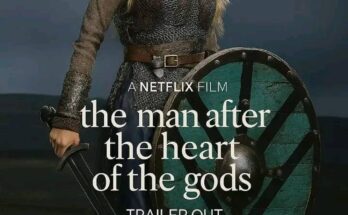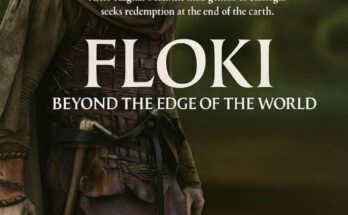The highly anticipated Netflix epic *Wrath of the Gods* has finally made its debut.
The release of Netflix’s Wrath of the Gods marks a monumental moment in streaming entertainment, bringing together a tapestry of mythology, human ambition, and breathtaking visual storytelling. From the moment the first trailer surfaced, anticipation for this epic had been building steadily, drawing the attention of both mythology enthusiasts and mainstream audiences eager for a story that promised to fuse ancient legends with modern cinematic grandeur. The film’s arrival is not merely a new addition to Netflix’s growing catalog of original content; it is a statement of ambition, signaling the platform’s desire to craft narratives that rival the scope and scale of traditional theatrical blockbusters. The storyline, which intertwines the fate of mortals with the whims and battles of deities, offers viewers a chance to explore timeless themes of power, revenge, love, and the enduring struggle between destiny and free will. What sets Wrath of the Gods apart from other mythologically inspired productions is its ability to humanize the gods themselves, depicting them not only as omnipotent beings but as characters whose desires, flaws, and rivalries mirror the complexities of humanity. This nuanced portrayal allows the audience to connect on a deeper emotional level, turning what could have been a distant and untouchable narrative into a deeply relatable story.
The production quality of Wrath of the Gods is immediately apparent, with every frame meticulously designed to transport viewers into a world that feels at once fantastical and palpably real. The set pieces range from sprawling temples and ancient cities to jagged, storm-swept landscapes, each location rendered with an attention to detail that reflects a profound respect for the source material. Costumes and visual effects work in harmony to evoke the majesty and terror of divine power, while the cinematography captures both the grandeur of mythic conflict and the intimate moments that define the characters’ emotional journeys. The film’s score, a sweeping orchestral arrangement punctuated by modern electronic motifs, underscores the epic nature of the narrative while enhancing the tension and drama of key scenes. Sound design, often an understated component of storytelling, is utilized masterfully here, immersing viewers in the clashing of swords, the rumble of thunder, and the ethereal whispers of the divine. Every technical choice demonstrates a commitment to crafting an experience that is as immersive as it is emotionally resonant.
Central to the appeal of Wrath of the Gods is its ensemble cast, which brings together a mix of established actors and rising talent. Their performances elevate the script, imbuing characters with depth and authenticity. The lead actors deliver particularly compelling portrayals of figures caught between the mortal and divine realms, embodying the struggle to navigate fate while asserting personal agency. Supporting characters, often gods or mythical creatures, are rendered with equal care, avoiding the pitfalls of caricature and instead presenting beings who are complex, unpredictable, and fully realized. Chemistry between characters is palpable, with alliances, betrayals, and romantic entanglements unfolding in ways that keep the audience invested from beginning to end. The writing balances dialogue-driven scenes with action-heavy sequences, ensuring that the narrative pace remains dynamic without sacrificing character development.
One of the most remarkable aspects of Wrath of the Gods is its treatment of mythology as a living, evolving narrative rather than a static collection of stories. The filmmakers have taken care to respect traditional sources while also reinterpreting myths for a contemporary audience. This approach allows for creative liberties that refresh familiar tales, offering new perspectives on well-known legends. Themes of divine justice, human resilience, and the consequences of hubris are explored with a sophistication that appeals to viewers of all ages. By blending historical context with imaginative reinterpretation, the film invites audiences to reconsider the relevance of ancient myths in the modern world, highlighting timeless questions about morality, power, and the human condition.
The pacing and structure of Wrath of the Gods reflect a careful consideration of audience engagement. Action sequences are interspersed with quieter, contemplative moments, allowing for a rhythm that mirrors the ebb and flow of the characters’ emotional arcs. The tension between mortals and gods is heightened through escalating stakes, each confrontation more intense than the last, culminating in a climax that is both visually stunning and narratively satisfying. Plot twists are woven seamlessly into the story, maintaining suspense while also revealing deeper layers of character motivation and thematic resonance. Despite the film’s grand scale, it never loses sight of the personal journeys at its core, ensuring that viewers remain emotionally invested even amidst large-scale battles and spectacular displays of divine power.
Beyond its narrative and technical achievements, Wrath of the Gods also represents a broader cultural moment. Its release contributes to a growing trend of streaming platforms producing epic, cinematic-quality content designed to compete with traditional film studios. By leveraging the accessibility and global reach of Netflix, the film can engage a diverse, international audience, introducing viewers from different cultural backgrounds to the richness of mythology while simultaneously offering universal themes that resonate across borders. The film’s visual language and storytelling approach make it accessible to newcomers, while the fidelity to mythological sources satisfies enthusiasts and scholars alike. This dual appeal enhances the film’s potential impact and underscores Netflix’s commitment to producing content that is both ambitious and widely appealing.
Social media response to Wrath of the Gods has been enthusiastic, with fans praising everything from its visual effects and action sequences to its thoughtful exploration of mythology. Conversations around the film highlight its ability to provoke discussion about the nature of power, the responsibilities of leadership, and the consequences of human actions. Fan theories, character analyses, and debates about the accuracy and interpretation of mythological events have flourished online, creating a sense of community and engagement around the film. This level of interaction demonstrates the cultural resonance of the story and reinforces the notion that epic storytelling continues to captivate audiences in the digital age.
The release of Wrath of the Gods is also noteworthy for its accessibility, as Netflix allows viewers to watch the film on multiple devices at their convenience. This flexibility enables a broader audience to experience the story without the constraints of theatrical schedules, making epic storytelling more democratic and inclusive. Additionally, the platform’s global reach ensures that the film can spark interest in mythology and storytelling traditions across different cultures, fostering appreciation for diverse narratives and encouraging cross-cultural dialogue. The film’s success on Netflix could influence the future of epic filmmaking, demonstrating that large-scale productions can thrive in the streaming ecosystem while maintaining artistic integrity and narrative depth.
In conclusion, Wrath of the Gods stands as a landmark release in Netflix’s catalog, merging mythology, human drama, and cinematic spectacle into a cohesive and compelling whole. Its careful balance of technical excellence, narrative depth, and character-driven storytelling ensures that it resonates with a wide audience, appealing to both longtime mythology enthusiasts and general viewers seeking an immersive cinematic experience. By humanizing gods, exploring timeless themes, and delivering breathtaking visuals, the film transcends the boundaries of traditional mythological adaptations, creating a story that is both epic in scale and profoundly personal in its emotional impact. Its release is a testament to the enduring power of myth and the possibilities of modern storytelling, offering viewers an unforgettable journey through the realms of gods and mortals alike. Wrath of the Gods is more than just a film; it is a cultural event, a testament to ambition, creativity, and the boundless potential of epic storytelling in the streaming era.



